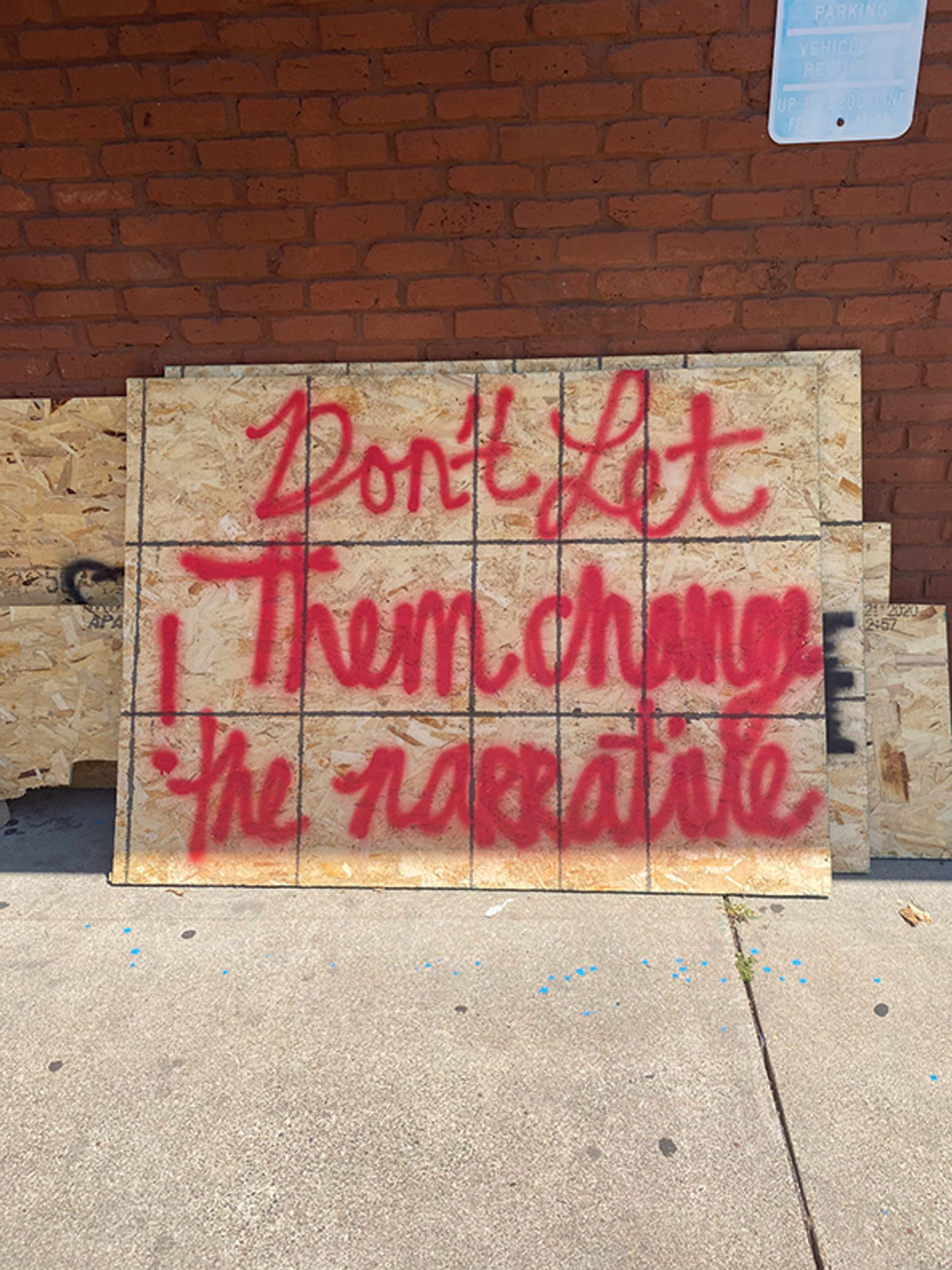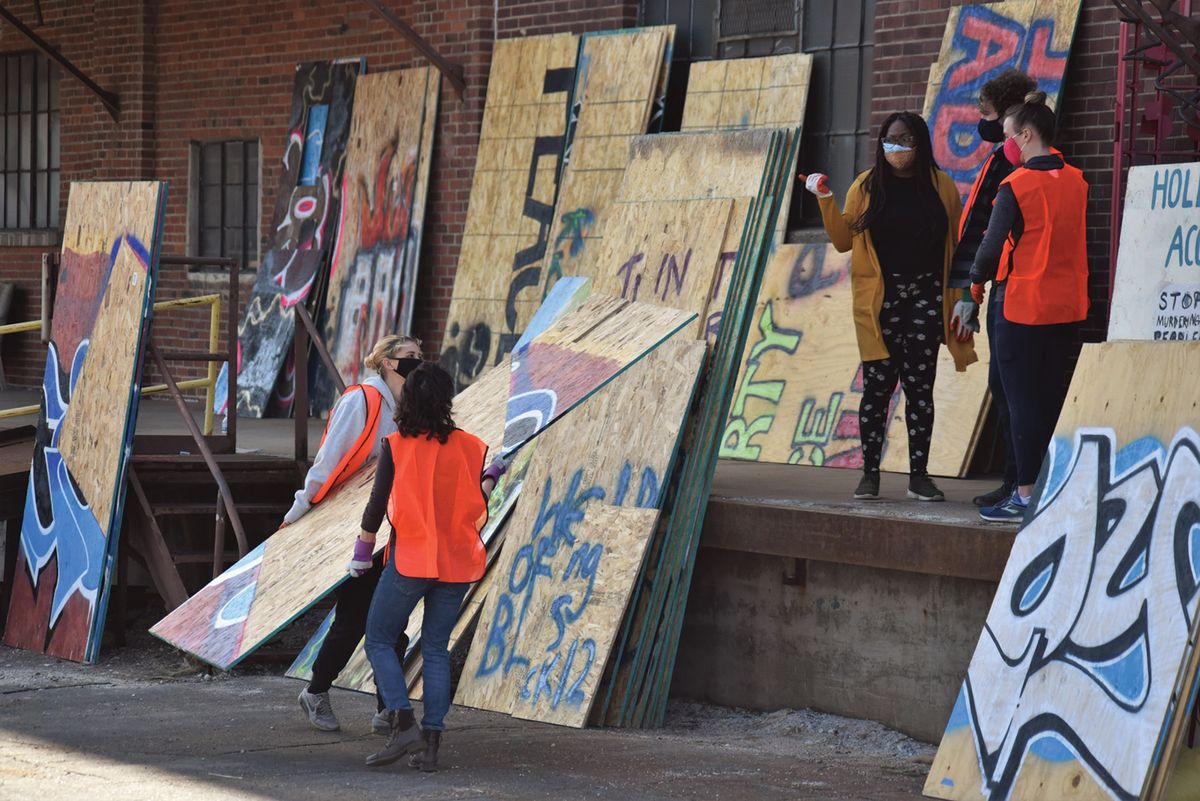The killing of Daunte Wright by a police officer last month has opened wounds afresh in Minnesota, where only a year ago the death of George Floyd, after police officer Derek Chauvin knelt on his neck for nine minutes and 29 seconds, sparked protests that spread across the country. With the trial of Chauvin just completed, and new demonstrations over Wright’s homicide, two grassroots groups, in partnership with a Black-led museum, are preserving work created in the aftermath of these events and readying an outdoor art exhibition. Featuring the messages, graffiti and murals made on plywood boards, which covered businesses during the civil unrest that erupted in 2020 after a video of Floyd’s death went viral, the show will also create a space to mourn Black lives senselessly lost.
Leesa Kelly is not an artist herself but has always felt connected to art in different forms. That was especially true when art popped up on plywood boards used to shutter Minneapolis and St Paul businesses in 2020 during mass demonstrations. “I think the murals spoke to me on a more emotional level,” Kelly says.
Some of the artwork on the boards is stunning, but for Kelly, they are also important historical artefacts. “There was a story there,” she says. “And that story spoke to me and mirrored my own story, and my own feelings and emotions. And I just thought it needed to be preserved and protected.”
How do we now create space for yet another tragedy—and memorialise that?Kenda Zellner-Smith, Save the Boards
Last summer, Kelly formed Memorialize the Movement, a group that is dedicated to preserving this work. It was an effort mirrored by another young Black woman, Kenda Zellner-Smith, who started her own grassroots group, Save the Boards, around the same time. They learned about each other’s work when they were both featured in an article by the Minneapolis Star Tribune’s Alicia Eler last July. Now, they share a storage facility and are working in collaboration with the Minnesota African American Heritage Museum and Gallery. With support from a team of researchers with backgrounds in museum studies or curatorial work from the University of St Thomas, they plan to present an exhibition in May of the boards in a Minneapolis park, near where Floyd was killed.
According to Kelly, the two groups continue to collect murals around the city, even as more boards are being erected in response to protests over Wright’s death, as well as worries that the results of Chauvin’s trial would spark even more unrest. [As we went to press, Chauvin was found guilty of murdering Floyd, to the relief of many in the Minneapolis community and the art world at large.]

Raw, powerful words written on a board that covered a fast-food restaurant’s windows during protests Courtesy of Save the Boards
“A lot of businesses chose to keep their boards up until after the trial, so as that comes to an end we are beginning to schedule pickups for late April, May and June,” Kelly says. “It is projected we will have somewhere around 1,000 boards by the end of the summer.”
Zellner-Smith says they have already seen businesses boarding up, with new messages saying things like, “Black owned”, or “Justice for Daunte”.
“We’re definitely going to start talking about, ‘How do we now create more space for yet another tragedy?’ and memorialise that, and make sure we don’t forget what happened in April, not even a full year after George’s murder,” Zellner-Smith says.
Like Kelly, Zellner-Smith never considered herself an artist, and she was not part of the art scene in Minnea-polis until she got involved with preserving the plywood boards that became canvases across the city. Zellner-Smith remembers playing near Cup Foods as a child—the corner shop now inextri-cably associated with Floyd’s death. “The whole situation really hit close to home,” she says.
When protests erupted in Minneapolis at the end of May 2020, -Zellner-Smith was living near Lyndale and 31st, near Lake Street, where many businesses were boarded up after fires and looting broke out there. Every day, she would walk to work at a health centre up town and look at the spray-painted messages, images and art on the streets. “I felt this sense of support from others in the community that I don’t think I have felt in the past,” she says.
She was especially drawn, both in her own neighbourhood and across the city, to the text-style messages that appeared on boards more so than the painted images. “The very simple, raw, real ones spoke to me first. Those were the reason I decided someone’s got to save these. I knew someone would take the initiative for the really colourful ones,” she says, but the ones featuring anti-police slogans, “those were gonna disappear”.
One example she gives is a board that covered the fast-food restaurant Hooks Fish and Chicken. “It says, ‘Don’t let them change the narrative,’” Zellner-Smith explains. “And it’s just in [plain] writing. It’s one of my all-time favourites because it just speaks to the point.” Another, on Hiawatha Avenue near the Third Precinct police station that burned to the ground, reads: “Do you hear us now?”
“That one spoke to me, because it did take burning down the city and making other people feel uncomfortable and scared to walk outside their front doors to understand the fear of living in America while being Black,” she says. “I feel like it really represented, ‘Do you understand how scary this is? Now do you understand the severity of the Black experience?’”
The death of 20-year-old Daunte Wright after being fatally shot by a cop during a traffic stop has made their work even more necessary. “I feel very numb,” Zellner-Smith says. “There’s a sense of urgency now. We’ve been doing this work in the name of George for eight, nine months. And then to see it happen again – it’s really disappointing.”
The exhibition, Justice for George: Messages from the People, will feature 200 boards, holding nearly 80 murals. That is just a fraction of the 800 boards the two groups have collected. They decided to make it into an annual event, showing 200 boards each time.
“We’re creating a whole new museum structure,” Kelly says. “We’re rejecting the traditional structure and creating one that works for Black and Brown people and our own stories.”
• Justice for George: Messages from the People runs from 21 to 23 May, Phelps Field Park, 701 E 39th St, Minneapolis, Minnesota


